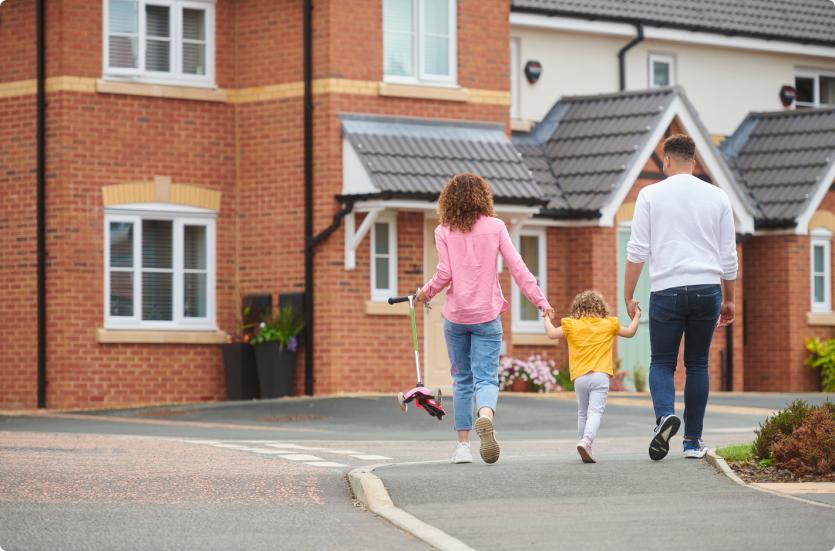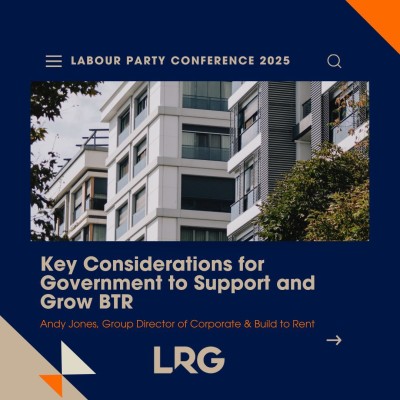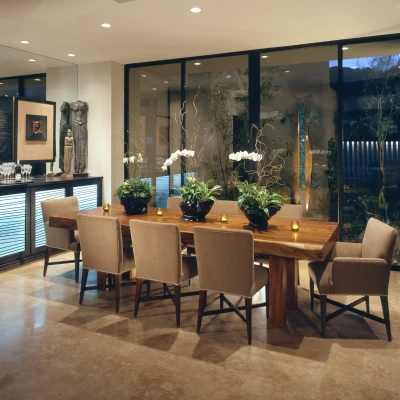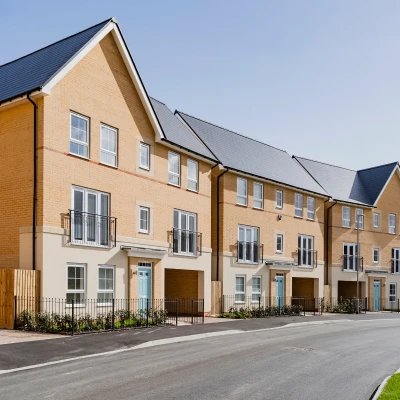BTR an Ideal Opportunity at times of Economic Instability

Investment in Build to Rent (BTR) has reached record levels and it is no coincidence that this has occurred as BTR expands beyond traditional city apartment units into BTR suburban communities – the emerging form of BTR which provides family homes and related services on new developments outside of cities.
Recent research among global institutional investors found that 70% anticipated being active in the suburban BTR market within the next five years: a substantial increase from the 42% currently active. The same survey found that institutional investors planned to invest a record £16.5bn in residential assets in 2022: a 65% increase from the £10.2bn spent in 2021. With John Lewis and others leading the way with significant success, the opportunities for developers are considerable and offer the potential to counter a slump in the residential sales market.
This is substantiated by the British Property Federation (BPF)’s Build to Rent Q1 2022 report which shows that in the last year alone, investment rose by 19%. Investment, according to Ascend Properties, has increased by an incredible 335% in the past decade. And there is potential for significantly more growth, as BTR currently accounts for no more than 2%[1] of the private rented sector (PRS).
Furthermore, the market is certain to grow. Even before the cost-of-living crisis and rising mortgage rates deterred would be first time buyers from stepping on to the property ladder, the proportion of households renting privately was increasing. According to the English Housing Survey 2022, the market has increased by 93% in the last 15 years, while the number of owner-occupied households has grown by just 3% over the same period.
The emergence of BTR suburban communities
BTR suburban communities have evolved to meet growing demand. In contrast to traditional BTR, this new iteration focuses on suburban rather than city locations, families rather than young professionals, houses rather than apartments, and typically offers shared outdoor spaces in place of indoor co-living. The BTR suburban communities model translates the hugely popular values of traditional BTR into a new context.
The key differences between suburban BTR communities and typical new settlements built primarily for market sale are service and flexibility. BTR generally offers a package which includes property maintenance, a variety of amenities and the flexibility for a tenant to move with ease from one unit to another as their requirements change.
LRG has been approached by many institutional investors interested in entering this new market. The common reason is the saturation of traditional BTR and the substantial opportunities for new BTR suburban communities, specifically for the increase in the number of families renting. Research carried out by the BPF in November 2021 analysed the tenant makeup of suburban BTR schemes across the UK and found that families equated to 43% of households - almost double the number families present in urban or ‘traditional’ BTR. Suburban BTR was also found to attract a wider age range, responding to the growing trend for multi-generational living.
The BTR suburban communities model appeals to investors because, in addition to homes being built specifically for this purpose, the model can provide a means through which to buy a portfolio of individual homes (currently the most profitable residential product) which can be aggregated to create a single investment unit. At LRG, because of the substantial number of properties on our books and strong links with local markets, we offer the means to continually expand clients’ portfolios as new properties become available. We’re currently seeing stronger competition for BTR suburban communities than for traditional BTR as institutional investors rush to capitalise on this growing asset class.
Furthermore, many clients who had previously invested in traditional buy to let (BTL) portfolios are moving towards the BTR model, partly because of the irrefutable demand, but also because with the benefit of a high level of services and reliable management, BTR investments are higher yielding than most residential or commercial assets.
Responding to the initiative to ‘professionalise’ the PRS
The opportunity to do so is well timed, as rising interest rates and potentially falling house prices have led people to consider rental as good short/medium term option.
Additionally, the opportunity for investment in BTR comes at a time when the traditional PRS is substantially challenged. Individual landlords face a raft of new regulations introduced by the Government to ‘professionalise’ the PRS. This determination, along with further regulations, was embodied in the June’s policy paper A fairer private rented sector, which paves the way for a Renters Reform Act due to be introduced in 2023. Essentially the Government’s aim is to rid the market of the archetypal 'rogue landlord' (who, the policy paper itself admitted, constitute just fraction of all landlords) – and to pass that opportunity to institutional investors and corporate landlords.
The withdrawal of thousands of amateur landlords from the market has led to a significant shortage of rental properties: according to Rightmove, the number of tenants in the UK increased by 6% in 2022 but this coincided with 50% fewer properties being available, and we have seen similar figures play out across our Leaders and Romans branches. These circumstances, added to the encouragement given by Government to institutional landlords, provides the perfect circumstances in which to invest in the PRS.
A favourable market
Government figures also demonstrate the extent to which the market is growing: the number of renting households with dependent children has doubled since 2003/4, making up 30% of the sector; and the same figures show that the number of ‘comfortable renters’ (defined as those in managerial professions, who hold degrees and are in good health) expanding too, with this demographic representing 44% of the rental sector. Of these approximately 1.94 million households a substantial proportion is expected to rent long term.
It is this growth and shift in the demographic profile that has turbo-charged BTR suburban communities. Providing desirable homes for families in fully-functioning serviced communities, this product – which offers growing families considerable flexibility and a wide range of options for a stress-free lifestyle, is undoubtedly the division of the property sector in which we will see the greatest growth over the next decade.
Furthermore its potential for expansion is almost unlimited, as counter-urbanising maturing Millennials seek family homes in bespoke communities. Those who have previously experienced the high level of service provided by traditional BTR are thought likely to provide the core market for BTR suburban communities. This innovative, service-based product will compare favourably with most of the stock currently available in the PRS, and the popularity of the product will enable BTR suburban communities to attract high levels of investment and grow rapidly, perhaps with even greater success than its multi-family BTR cousin.
Diversity in portfolios
For investors, there are other distinct advantages of BTR suburban communities. One is that the variety of property types (residential, commercial, retail and leisure) which exist within any one portfolio, creating immediate sales revenue and long-term rental revenue, with the potential to spread the investment according to the market conditions.
With higher inflation likely for the foreseeable future, residential property (the value of which has increased by more than 60% over the last ten years, according to Nationwide) is invariably a safer option than more fluid investments. Despite political and economic uncertainty, figures from the Office for National Statistics[2] show new build prices up 26.5% in a year.
In our 40 years’ experience as lettings and management agents, we have seen institutional investors disregard residential property as too fragmented and management-intensive. Free of these restrains, the BTR suburban communities model appeals to investors specifically because it enables them to acquire a portfolio of residential and commercial properties, aggregated to create a single investment unit. At LRG, because of the substantial number of properties on our books and strong links with local markets, we have the added advantage of enabling clients to expand their portfolios as new opportunities become available. We’re currently seeing stronger demand for BTR suburban communities than for traditional BTR, as, offering a high level of services and reliable management, BTR investments are higher-yielding than most residential or commercial assets.
So despite the currently political and economic turmoil, the future for BTR suburban communities shows no sign of abating. Amalgamation with other property classes including the later living and affordable housing sectors, joint ventures leading to innovative cross-subsidies, and public/private partnerships are adding to the wide-ranging appeal.
Furthermore, the BTR suburban communities model in the UK has some catching up to do with other markets: in Europe a high proportion families rent (as many as 60%, for example, in Switzerland) and in the US the predominant form of BTR, accounting for 70% of the market, is larger, family-oriented homes, within low-rise, suburban developments.
A preference for residential property
Prior to the pandemic, institutional investment in UK real estate was focused on commercial property. But the world has changed, and residential property is demonstrably the more robust asset class, with yields consistently out-stripping those of the commercial sector. LRG has seen significantly increased interest in BTR by institutional investors, including from owners of either commercial or retail properties (which may be converted into residential under Permitted Development Rights) and simultaneously, retail property investors and operators such as the John Lewis Partnership, which has recently revealed the first three locations where it plans to debut its ambitious plans for the BTR market[3].
Meeting ESG goals
Finally, the appeal of BTR suburban communities includes the ability to address the ESG goals which rank highly as an objective of institutional investors.
Corporate entities such as John Lewis moving BTR is prompted by social responsibility: John Lewis plans to address inadequacies in the PRS by offering, ‘the trust, quality and service that people expect from John Lewis and potentially offering discounted rents to the Partnership's 80,000-strong workforce’.
Furthermore, with up to 20% of gross domestic product globally at risk from carbon emissions[4] and institutional investors committed to meeting net zero targets, the BTR sector is at the forefront of innovation in energy efficiency. In BTR suburban communities, with the potential for combined heat plants alongside other opportunities for renewable energy and sustainable features, environmentally responsible solutions can be incorporated effectively as a result of scale and potential for efficiencies. Furthermore, the main reason why homeowners resist renewable energy features such as air source heat pumps is often concerns about maintenance – availability of both parts and technicians. Where snagging, maintenance and emergency work is the responsibility of experienced property managers, this is no longer a reason to forgo the more sustainable option.
Opportunities for expansion
The many opportunities for expansion include the potential for BTR suburban communities to incorporate later living accommodation and to form partnerships with local authorities and housing associations which enable BTR to cross-subsidise other property assets including schools and leisure facilities offer opportunities joint ventures.
Recent analysis by the BPF states that the BTR sector could be worth £170bn by 2032, with the number of units set to rise from 76,800 to more than 380,000. Our experience to date substantiates this prediction, and we look forward to the inevitable rise in BTR suburban communities in the UK.
[1] According to research by Knight Frank, completed stock accounts for 1.3% of all private rental households, rising to 2.2% if the pipeline of under construction stock is included.
[2] As reported in The Times 21 November 2022
[3] https://www.johnlewispartnership.co.uk/media/press/y2022/jlp-announces-first-proposed-locations-for-rental-homes.html
[4] https://www.sifma.org/wp-content/uploads/12/Climate-Finance-Markets-and-the-Real-Economy.pdf

Contact Us
Got a question, general enquiry or something else?
You may also like
Since we started in 1987 we have grown to one of the UK’s largest property groups, we can save you time and money by offering a range of services and expertise under one roof.



